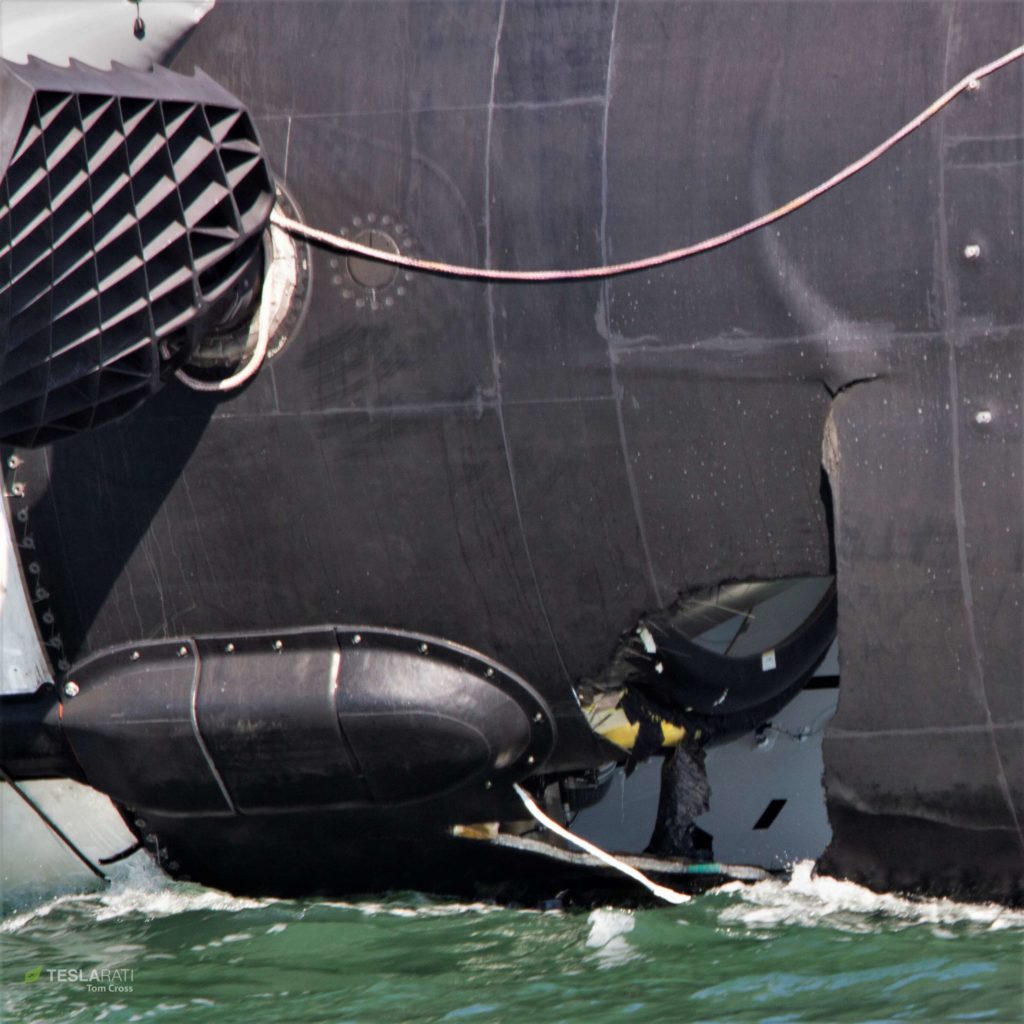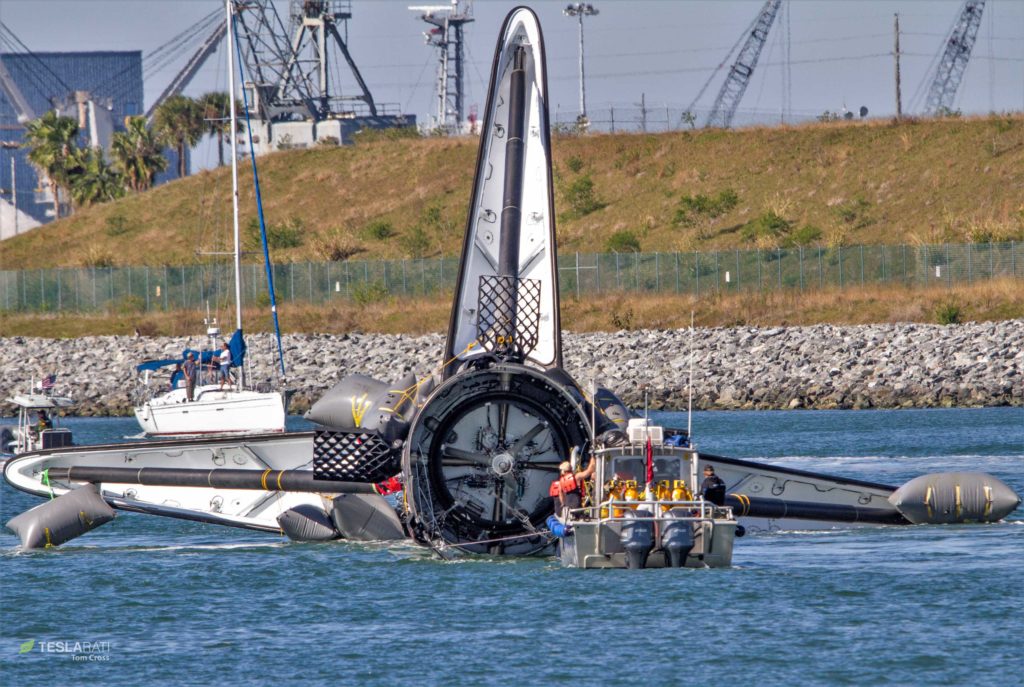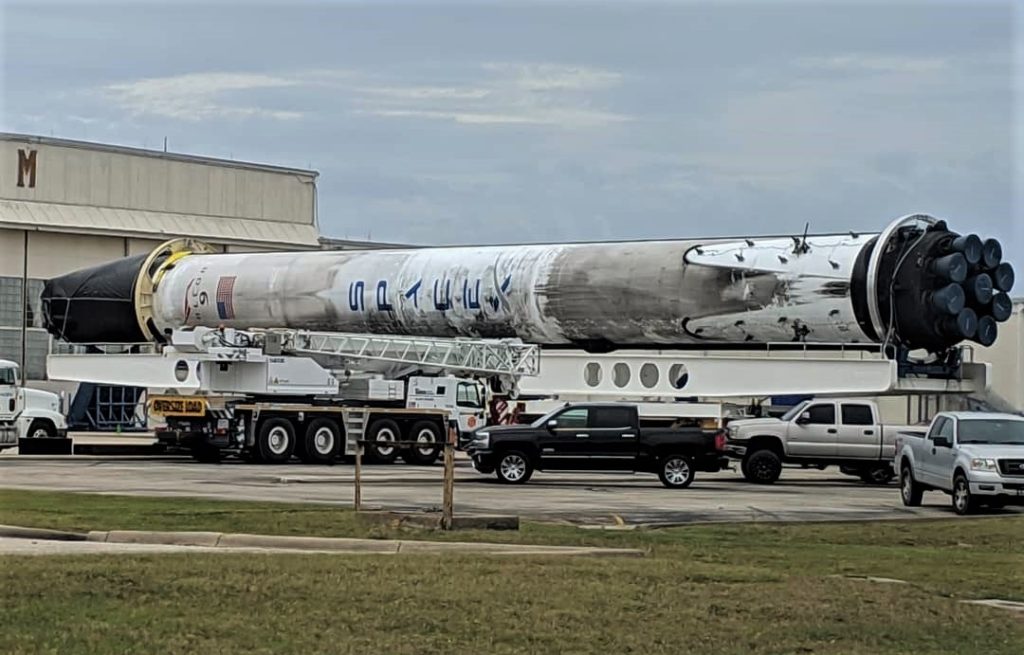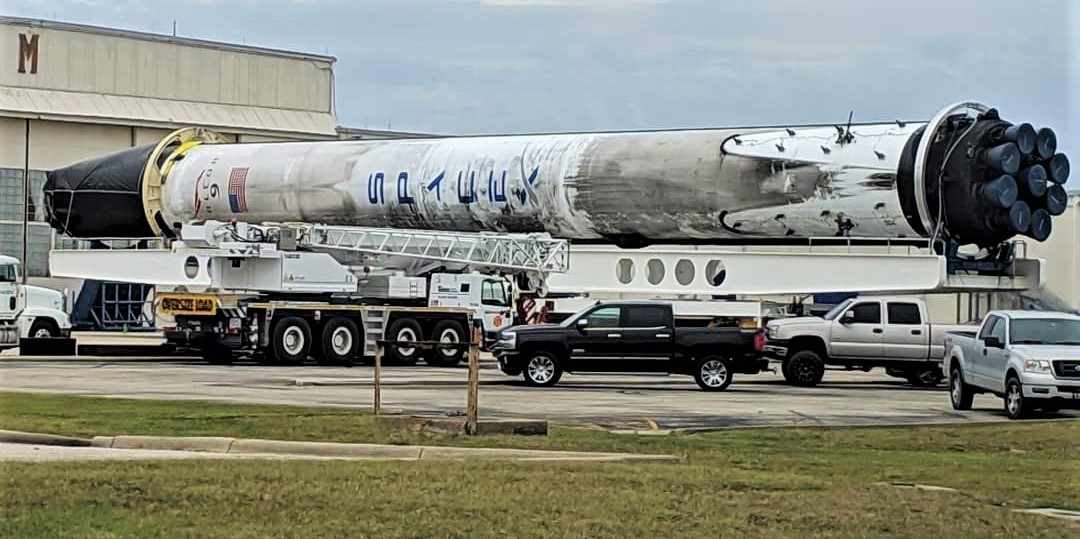
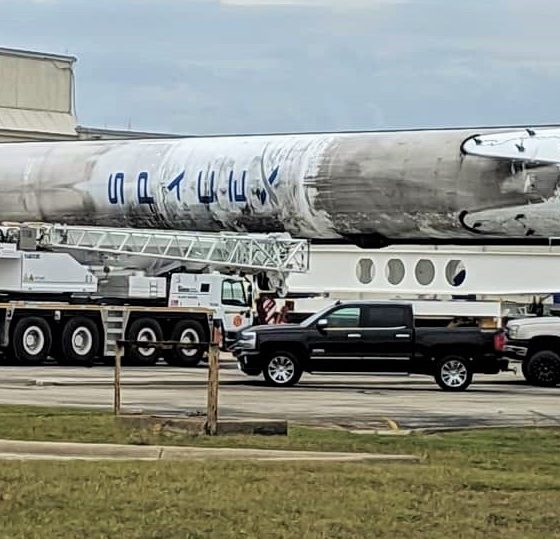
News
SpaceX lifts soggy Falcon 9 Block 5 booster ashore after accidental splashdown
Independent group USLaunchReport has published a video capturing the entirety of SpaceX’s ad hoc East Coast Falcon 9 recovery operations, in which forlorn booster B1050 had to be carefully extracted out of the ocean after an unintentional soft-landing in the Atlantic following its successful Dec. 5 launch debut.
72 hours after B1050’s water landing and some painstaking preparation, the booster was towed to SpaceX’s dock space in Port Canaveral, where it spent just a brief few hours floating adjacent to drone ship Of Course I Still Love You and the rest of the company’s Florida fleet. Considerably less than twelve hours after arriving, technicians had already managed to lift the rocket out of the ocean and onto dry land, where another week or so was spent preparing Falcon 9 for transport.
Given the extent of the damage to the Block 5 booster’s interstage and the basic fact that SpaceX recovery technicians and engineers had never attempted anything quite like it before, it was fairly impressive that they took barely six hours to lift the booster out of the water, particularly considering that the rocket appeared to be filled with hundreds or even thousands of gallons of water. No visible damage was caused, although there was clearly some cause for extensive discussion and preparation per an unusually large and lengthy huddle of more than 30 employees prior to the beginning of the lift.
https://twitter.com/_TomCross_/status/1071886823721447424
Once on land, B1050 had an unusual sling placed exactly where the Falcon 9 booster’s liquid oxygen (LOx) and kerosene (RP-1) propellant tanks were welded together, apparently a location that is particularly sensitive to off-nominal X-axis stress. To give context, imagine bending a cardboard tube or straw in half instead of trying to push its ends together – Falcon 9’s structure is quite similar in concept. Built primarily 5mm-thick sheets of lithium-aluminum alloy, Falcon 9’s propellant tanks are extremely thin and light while also being aggressively optimized for vertical (up and down) loading, i.e. the forces experienced while accelerating (and eventually decelerating) through the atmosphere during launch and landing.
As a result, SpaceX almost always pressurizes the first stage propellant tanks of Falcon 9 with nitrogen whenever boosters are horizontal without physical support at their bendy centers. In the case of B1050, SpaceX almost certainly concluded that using its waterlogged umbilical ports to inject nitrogen into its tanks was too much of a risk without knowing the precise condition of the piping and the tanks themselves, opting instead to go with a simple sling to prevent damage from unintended bending. Thankfully, B1050 appears to have made it through its dry land ordeal even better than the time it spent in the Atlantic, suffering no visible damage whatsoever.
- Sad interstage is sad. (Tom Cross)
- An almost impossibly rare view. (Tom Cross)
- That’s no boat… (Teslarati)
- SpaceX technicians had to go through the normal process of Falcon 9 booster recovery at a decidedly abnormal 90 degree delta. (Tom Cross)
- Falcon 9 B1050 was spotted at CCAFS near hangars SpaceX leases for refurbishment. (Instagram/anonymous)
Somewhere between December 14 and 15, the booster was at long last lifted onto SpaceX’s primary East Coast booster transporter and carefully drove the rocket to one of its 2-3 Cape Canaveral Air Force Station (CCAFS) refurbishment and storage hangars, avoiding detection by all but a few passersby. This could full well be the last we see (and even hear) of poor old Falcon 9 B1050, but there is still a decent chance that SpaceX hopes the entire rocket or major components can be easily salvaged.
Given the extreme care taken during the booster’s lift onto land and the week it spent having legs and grid fins removed, it can be definitively concluded that an effort will be made to save the entire vehicle (sans interstage). If it has managed to make it through the past two weeks largely unscathed, it may well become the first Falcon 9 to conduct a dedicated launch of multiple Starlink satellites sometime in the second half of 2019, at least according to CEO Elon Musk’s vague suggestion that it could fly on an “internal SpaceX mission”.
We may use it for an internal SpaceX mission
— Elon Musk (@elonmusk) December 5, 2018
For prompt updates, on-the-ground perspectives, and unique glimpses of SpaceX’s rocket recovery fleet check out our brand new LaunchPad and LandingZone newsletters!

Elon Musk
Elon Musk’s X will start using a Tesla-like software update strategy
The initiative seems designed to accelerate updates to the social media platform, while maintaining maximum transparency.

Elon Musk’s social media platform X will adopt a Tesla-esque approach to software updates for its algorithm.
The initiative seems designed to accelerate updates to the social media platform, while maintaining maximum transparency.
X’s updates to its updates
As per Musk in a post on X, the social media company will be making a new algorithm to determine what organic and advertising posts are recommended to users. These updates would then be repeated every four weeks.
“We will make the new 𝕏 algorithm, including all code used to determine what organic and advertising posts are recommended to users, open source in 7 days. This will be repeated every 4 weeks, with comprehensive developer notes, to help you understand what changed,” Musk wrote in his post.
The initiative somewhat mirrors Tesla’s over-the-air update model, where vehicle software is regularly refined and pushed to users with detailed release notes. This should allow users to better understand the details of X’s every update and foster a healthy feedback loop for the social media platform.
xAI and X
X, formerly Twitter, has been acquired by Elon Musk’s artificial intelligence startup, xAI last year. Since then, xAI has seen a rapid rise in valuation. Following the company’s the company’s upsized $20 billion Series E funding round, estimates now suggest that xAI is worth tens about $230 to $235 billion. That’s several times larger than Tesla when Elon Musk received his controversial 2018 CEO Performance Award.
As per xAI, the Series E funding round attracted a diverse group of investors, including Valor Equity Partners, Stepstone Group, Fidelity Management & Research Company, Qatar Investment Authority, MGX, and Baron Capital Group, among others. Strategic partners NVIDIA and Cisco Investments also continued support for building the world’s largest GPU clusters.
News
Tesla FSD Supervised wins MotorTrend’s Best Driver Assistance Award
The decision marks a notable reversal for the publication from prior years, with judges citing major real-world improvements that pushed Tesla’s latest FSD software ahead of every competing ADAS system.

Tesla’s Full Self-Driving (Supervised) system has been named the best driver-assistance technology on the market, earning top honors at the 2026 MotorTrend Best Tech Awards.
The decision marks a notable reversal for the publication from prior years, with judges citing major real-world improvements that pushed Tesla’s latest FSD software ahead of every competing ADAS system. And it wasn’t even close.
MotorTrend reverses course
MotorTrend awarded Tesla FSD (Supervised) its 2026 Best Tech Driver Assistance title after extensive testing of the latest v14 software. The publication acknowledged that it had previously criticized earlier versions of FSD for erratic behavior and near-miss incidents, ultimately favoring rivals such as GM’s Super Cruise in earlier evaluations.
According to MotorTrend, the newest iteration of FSD resolved many of those shortcomings. Testers said v14 showed far smoother behavior in complex urban scenarios, including unprotected left turns, traffic circles, emergency vehicles, and dense city streets. While the system still requires constant driver supervision, judges concluded that no other advanced driver-assistance system currently matches its breadth of capability.
Unlike rival systems that rely on combinations of cameras, radar, lidar, and mapped highways, Tesla’s FSD operates using a camera-only approach and is capable of driving on city streets, rural roads, and freeways. MotorTrend stated that pure utility, the ability to handle nearly all road types, ultimately separated FSD from competitors like Ford BlueCruise, GM Super Cruise, and BMW’s Highway Assistant.
High cost and high capability
MotorTrend also addressed FSD’s pricing, which remains significantly higher than rival systems. Tesla currently charges $8,000 for a one-time purchase or $99 per month for a subscription, compared with far lower upfront and subscription costs from other automakers. The publication noted that the premium is justified given FSD’s unmatched scope and continuous software evolution.
Safety remained a central focus of the evaluation. While testers reported collision-free operation over thousands of miles, they noted ongoing concerns around FSD’s configurable driving modes, including options that allow aggressive driving and speeds beyond posted limits. MotorTrend emphasized that, like all Level 2 systems, FSD still depends on a fully attentive human driver at all times.
Despite those caveats, the publication concluded that Tesla’s rapid software progress fundamentally reshaped the competitive landscape. For drivers seeking the most capable hands-on driver-assistance system available today, MotorTrend concluded Tesla FSD (Supervised) now stands alone at the top.
News
Elon Musk’s Grokipedia surges to 5.6M articles, almost 79% of English Wikipedia
The explosive growth marks a major milestone for the AI-powered online encyclopedia, which was launched by Elon Musk’s xAI just months ago.

Elon Musk’s Grokipedia has grown to an impressive 5,615,201 articles as of today, closing in on 79% of the English Wikipedia’s current total of 7,119,376 articles.
The explosive growth marks a major milestone for the AI-powered online encyclopedia, which was launched by Elon Musk’s xAI just months ago. Needless to say, it would only be a matter of time before Grokipedia exceeds English Wikipedia in sheer volume.
Grokipedia’s rapid growth
xAI’s vision for Grokipedia emphasizes neutrality, while Grok’s reasoning capabilities allow for fast drafting and fact-checking. When Elon Musk announced the initiative in late September 2025, he noted that Grokipedia would be an improvement to Wikipedia because it would be designed to avoid bias.
At the time, Musk noted that Grokipedia “is a necessary step towards the xAI goal of understanding the Universe.”
Grokipedia was launched in late October, and while xAI was careful to list it only as Version 0.1 at the time, the online encyclopedia immediately earned praise. Wikipedia co-founder Larry Sanger highlighted the project’s innovative approach, noting how it leverages AI to fill knowledge gaps and enable rapid updates. Netizens also observed how Grokipedia tends to present articles in a more objective manner compared to Wikipedia, which is edited by humans.
Elon Musk’s ambitious plans
With 5,615,201 total articles, Grokipedia has now grown to almost 79% of English Wikipedia’s article base. This is incredibly quick, though Grokipedia remains text-only for now. xAI, for its part, has now updated the online encyclopedia’s iteration to v0.2.
Elon Musk has shared bold ideas for Grokipedia, including sending a record of the entire knowledge base to space as part of xAI’s mission to preserve and expand human understanding. At some point, Musk stated that Grokipedia will be renamed to Encyclopedia Galactica, and it will be sent to the cosmos.
“When Grokipedia is good enough (long way to go), we will change the name to Encyclopedia Galactica. It will be an open source distillation of all knowledge, including audio, images and video. Join xAI to help build the sci-fi version of the Library of Alexandria!” Musk wrote, adding in a later post that “Copies will be etched in stone and sent to the Moon, Mars and beyond. This time, it will not be lost.”
